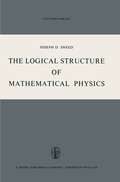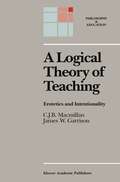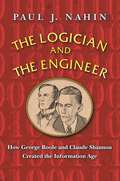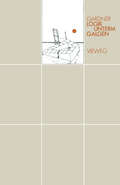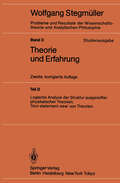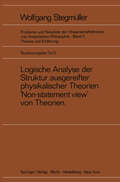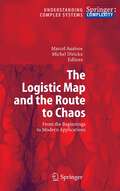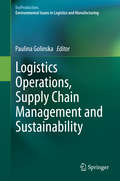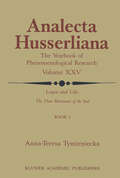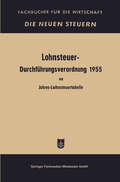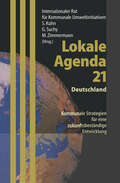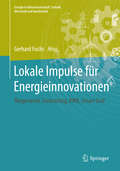- Table View
- List View
The Logical Structure of Mathematical Physics (Synthese Library #35)
by J.D. SneedThis book is about scientific theories of a particular kind - theories of mathematical physics. Examples of such theories are classical and relativis tic particle mechanics, classical electrodynamics, classical thermodynamics, statistical mechanics, hydrodynamics, and quantum mechanics. Roughly, these are theories in which a certain mathematical structure is employed to make statements about some fragment of the world. Most of the book is simply an elaboration of this rough characterization of theories of mathematical physics. It is argued that each theory of mathematical physics has associated with it a certain characteristic mathematical struc ture. This structure may be used in a variety of ways to make empirical claims about putative applications of the theory. Typically - though not necessarily - the way this structure is used in making such claims requires that certain elements in the structure play essentially different roles. Some playa "theoretical" role; others playa "non-theoretical" role. For example, in classical particle mechanics, mass and force playa theoretical role while position plays a non-theoretical role. Some attention is given to showing how this distinction can be drawn and describing precisely the way in which the theoretical and non-theoretical elements function in the claims of the theory. An attempt is made to say, rather precisely, what a theory of mathematical physics is and how you tell one such theory from anothe- what the identity conditions for these theories are.
The Logical Structure of Mathematical Physics
by Joseph D. SneedThis book is about scientific theories of a particular kind - theories of mathematical physics. Examples of such theories are classical and relativis tic particle mechanics, classical electrodynamics, classical thermodynamics, statistical mechanics, hydrodynamics, and quantum mechanics. Roughly, these are theories in which a certain mathematical structure is employed to make statements about some fragment of the world. Most of the book is simply an elaboration of this rough characterization of theories of mathematical physics. It is argued that each theory of mathematical physics has associated with it a certain characteristic mathematical struc ture. This structure may be used in a variety of ways to make empirical claims about putative applications of the theory. Typically - though not necessarily - the way this structure is used in making such claims requires that certain elements in the structure play essentially different roles. Some playa "theoretical" role; others playa "non-theoretical" role. For example, in classical particle mechanics, mass and force playa theoretical role while position plays a non-theoretical role. Some attention is given to showing how this distinction can be drawn and describing precisely the way in which the theoretical and non-theoretical elements function in the claims of the theory. An attempt is made to say, rather precisely, what a theory of mathematical physics is and how you tell one such theory from anothe- what the identity conditions for these theories are.
A Logical Theory of Teaching: Erotetics and Intentionality (Philosophy and Education #1)
by C.J.B. Macmillan James W. Garrisonhappens, how it happens, and why it happens. Our assumption ought to be that this is as true in education as it is in atomic physics. But this leaves many other questions to answer. The crucial ones: What kind of science is proper or appropriate to education? How does it differ from physics? What is wrong with the prevai1~ ing, virtually unopposed research tradition in education? What could or should be done to replace it with a more adequate tradi tion? What concepts are necessary to describe and explain what we find there? It is in this realm that we find ourselves. Where to start? One place - our place, needless to say - is with one limited but central concept in education, teaching. A long philosophical tradition concerned with the nature of teaching goes back (along with everything else) to Plato, divulging most recent ly in the work of such philosophers as B. O. Smith, Scheffler, Hirst, Komisar, Green, McClellan, Soltis, Kerr, Fenstermacher, et al. An empirical tradition runs parallelto the philosophers -it has its most notable modern proponents in Gage, the Soars, Berliner, Rosen shine, but its roots can be traced to the Sophists. These two tradi tions have been at loggerheads over the centuries.
The Logician and the Engineer: How George Boole and Claude Shannon Created the Information Age
by Paul J. NahinBoolean algebra, also called Boolean logic, is at the heart of the electronic circuitry in everything we use—from our computers and cars, to home appliances. How did a system of mathematics established in the Victorian era become the basis for such incredible technological achievements a century later? In The Logician and the Engineer, Paul Nahin combines engaging problems and a colorful historical narrative to tell the remarkable story of how two men in different eras—mathematician and philosopher George Boole and electrical engineer and pioneering information theorist Claude Shannon—advanced Boolean logic and became founding fathers of the electronic communications age. Nahin takes readers from fundamental concepts to a deeper and more sophisticated understanding of modern digital machines, in order to explore computing and its possible limitations in the twenty-first century and beyond.
The Logician and the Engineer: How George Boole and Claude Shannon Created the Information Age
by Paul J. NahinBoolean algebra, also called Boolean logic, is at the heart of the electronic circuitry in everything we use—from our computers and cars, to home appliances. How did a system of mathematics established in the Victorian era become the basis for such incredible technological achievements a century later? In The Logician and the Engineer, Paul Nahin combines engaging problems and a colorful historical narrative to tell the remarkable story of how two men in different eras—mathematician and philosopher George Boole and electrical engineer and pioneering information theorist Claude Shannon—advanced Boolean logic and became founding fathers of the electronic communications age. Nahin takes readers from fundamental concepts to a deeper and more sophisticated understanding of modern digital machines, in order to explore computing and its possible limitations in the twenty-first century and beyond.
The Logico-Algebraic Approach to Quantum Mechanics: Volume I: Historical Evolution (The Western Ontario Series in Philosophy of Science #5a)
by C. A. HookerThe twentieth century has witnessed a striking transformation in the un derstanding of the theories of mathematical physics. There has emerged clearly the idea that physical theories are significantly characterized by their abstract mathematical structure. This is in opposition to the tradi tional opinion that one should look to the specific applications of a theory in order to understand it. One might with reason now espouse the view that to understand the deeper character of a theory one must know its abstract structure and understand the significance of that struc ture, while to understand how a theory might be modified in light of its experimental inadequacies one must be intimately acquainted with how it is applied. Quantum theory itself has gone through a development this century which illustrates strikingly the shifting perspective. From a collection of intuitive physical maneuvers under Bohr, through a formative stage in which the mathematical framework was bifurcated (between Schrödinger and Heisenberg) to an elegant culmination in von Neumann's Hilbert space formulation the elementary theory moved, flanked even at the later stage by the ill-understood formalisms for the relativistic version and for the field-theoretic altemative; after that we have a gradual, but constant, elaboration of all these quantal theories as abstract mathematical struc tures (their point of departure being von Neumann's formalism) until at the present time theoretical work is heavily preoccupied with the manip ulation of purely abstract structures.
Logik der Morphologie im Rahmen einer Logik der gesamten Biologie
by Adolf MeyerDieser Buchtitel ist Teil des Digitalisierungsprojekts Springer Book Archives mit Publikationen, die seit den Anfängen des Verlags von 1842 erschienen sind. Der Verlag stellt mit diesem Archiv Quellen für die historische wie auch die disziplingeschichtliche Forschung zur Verfügung, die jeweils im historischen Kontext betrachtet werden müssen. Dieser Titel erschien in der Zeit vor 1945 und wird daher in seiner zeittypischen politisch-ideologischen Ausrichtung vom Verlag nicht beworben.
Logische Analyse der Struktur ausgereifter physikalischer Theorien ‘Non-statement view’ von Theorien (Probleme und Resultate der Wissenschaftstheorie und Analytischen Philosophie #2 / D)
by Wolfgang Stegmüller1. Falsche Orientierung am großen Bruder? Auf die Frage nach dem Gegenstand der Wissenschaftstheorie könnte man die Antwort geben: "Kein Mensch weiß, wovon die Wissenschafts theorie handelt; denn sie ist eine Disziplin ohne Objekt." Dies würde an die Art und Weise erinnern, in der einst B. RUSSELL die Mathematik charak terisierte. Aber während er in der für ihn typischen humorvollen Weise auf das Problem der mathematischen Erkenntnis hinweisen wollte, könnte die vorliegende Antwort durchaus ernst gemeint sein und das heißt hier: durchaus boshaft. Die Behauptung ließe sich durch einen Vergleich mit der Situation in der Philosophie der Mathematik stützen. Die Entwicklung der Philosophie der Mathematik zu einer exakten Wissenschaft, genannt Metamathematik, ist Da diese durch die mathematische Grundlagenkrise hervorgerufen worden. Krise durch die Entdeckung der mengentheoretischen Antinomien aus gelöst wurde, wird sie oft so dargestellt, als habe es sich dabei um ein tragisches Ereignis in der modernen Mathematik gehandelt. Betrachtet man diesen Vorgang unter dem Aspekt der Wirkung, so ge langt man eher zu der gegenteiligen Beurteilung: Die Entdeckung von Antinomien war ein höchstgliickliches Ereignis; denn sie bewirkte den Zwang zur Formalisierung und Präzisierung des Erkenntnisgegenstandes der Phi losophie der Mathematik. Intuitive Vorstellungen vom mathematischen Denken wurden durch genau beschreib bare Objekte ersetzt und die Philo sophie der Mathematik entwickelte sich zur mathematischen Grundlagen forschung, die in allen ihren Verzweigungen zu Disziplinen führte, die der Mathematik an Präzision nicht nachstanden und die heute selbst als Teile der Mathematik angesehen werden.
Logische Analyse der Struktur ausgereifter physikalischer Theorien ‘Non-statement view’ von Theorien (Probleme und Resultate der Wissenschaftstheorie und Analytischen Philosophie #2 / D)
by Wolfgang StegmüllerLogischer Empirismus, Lebensreform und die deutsche Jugendbewegung: Logical Empiricism, Life Reform, and the German Youth Movement (Veröffentlichungen des Instituts Wiener Kreis #32)
by Christian Damböck Günther Sandner Meike G. WernerThis open-access book is the first to investigate the roots of Logical Empiricism in the context of the Life Reform and the German Youth Movements. Rudolf Carnap and Hans Reichenbach are the key protagonists; they both belonged to the German Youth Movement and developed their early philosophical views in this setting. By combining scholarly essays with unpublished and hard to access manuscripts, letters, and articles, this volume recasts our understanding of the early years of Logical Empiricism.
Logischer Empirismus, Werte und Moral: Eine Neubewertung (Veröffentlichungen des Instituts Wiener Kreis)
by Anne SiegetsleitnerTrotz ihres sozialen und politischen Engagements wurden die Logischen Empiristen – allen voran die Mitglieder des Wiener Kreises – nicht für ihr Interesse an Ethik und Wertphilosophie bekannt. Ihnen wurde sogar vorgeworfen, Werte und Moral zu zerstören. Die Autorinnen und Autoren liefern in diesem Band eine längst fällige Neubewertung logisch-empiristischer Positionen hinsichtlich der Frage von Werten und Moral. Sie beleuchten die wissenschaftlich-humanistisch motivierte Ablehnung traditioneller Ethik jenseits von vorherrschenden Klischeebildern.
The Logistic Map and the Route to Chaos: From the Beginnings to Modern Applications (Understanding Complex Systems)
by Marcel Ausloos Michel DirickxPierre-Francois Verhulst, with his seminal work using the logistic map to describe population growth and saturation, paved the way for the many applications of this tool in modern mathematics, physics, chemistry, biology, economics and sociology. Indeed nowadays the logistic map is considered a useful and paradigmatic showcase for the route leading to chaos. This volume gathers contributions from some of the leading specialists in the field to present a state-of-the art view of the many ramifications of the developments initiated by Verhulst over a century ago.
Logistic Optimization of Chemical Production Processes
by Sebastian EngellIn this first book dedicated to the logistics of chemical plants and production processes, authors from academia and industry -- such as Bayer, Degussa, Merck -- provide an overview of the field, incorporating the knowledge and experience gathered over the last 10 years. In so doing, they describe the latest ideas on efficient design, illustrating when to produce which part of the equipment and with which resources, so as to optimize chemical plants for high capacity and flexibility. This book gives an overview of the state-of-the-art of the whole logistic chain of chemical production processes. Alongside the fundamentals, tools and algorithms, and integration issues, the book features five significant industrial case studies.
Logistics Operations, Supply Chain Management and Sustainability (EcoProduction)
by Paulina GolinskaThe aim of this book is to present qualitative and qualitative aspects of logistics operations and supply chain management which help to implement the sustainable policy principles in the companies and public sector’s institutions. Authors in individual chapters address the issues related to reverse network configuration, forward and reverse supply chain integration, CO2 reduction in transportation, improvement of the production operations and management of the recovery activities. Some best practices from different countries and industries are presented. This book will be valuable to both academics and practitioners wishing to deepen their knowledge in the field of logistics operations and management with regard to sustainability issues.
Logos and Life: The Spontaneous and the Creative in Man’s Self-Interpretation-in-the-Sacred (Analecta Husserliana #25)
by Anna-Teresa TymienieckaPART I THE CRITIQUE OF REASON CONTINUED: FROM LOGOS TO ANTI-LOGOS 1. THE NEW CRITIQUE OF REASON A new critique of reason is the crucial task imposed on the philosophy of our times as we emerge more and more from so-called "modernism" into a historical phase which will have to take its own paths and find its own determination. It may be considered that the main developmental line of modern times in its philosophy as well as in its culture at large was traced by the Cartesian cogito. The unfolding of Occidental philos ophy has culminated in reason or intellect's being awarded the central place. This is its specific trait. We can see a direct line of progression from the cogito to Kant's Critique. It is no wonder that this work is the landmark of modern philosophy. Kant's Critique was concerned with the foundation of the sciences. Edmund-Husserllaunched a second major, renewed, critique of reason, one which addresses not only the critical situation of the sciences but extends the critique even to the situation of Occidental culture as its malaise is diagnosed by this great thinker. Edmund Husserl voiced, in fact, the conviction that Occidental humanity has reached in our age the peak of its unfolding. His identify ing this peak with the formulation of phenomenological philosophy strikes at the point in which the significant and novel developments of Occidental culture and philosophy (phenomenology, that is) coincide.
Logos of Phenomenology and Phenomenology of The Logos. Book Four: The Logos of Scientific Interrogation, Participating in Nature-Life-Sharing in Life (Analecta Husserliana #91)
by Anna-Teresa TymienieckaPrompted and ever diversified by the specifically human interrogative logos, scientific inquiries seek a common system of links in order to mutually confirm and rectify their results. Coming closer and closer to phenomenology, the sciences of life find the common ground of the reality in the ontopoiesis of life. Could it not be that the interrogative logos of science, participating in human creative inventiveness will bring together also the divergent scientific methods in a common network? A network which comprises natural processes, societal sharing-in-life, and existential communication.
Lohnsteuer-Durchführungsverordnung: in der Fassung der Verordnung vom 21. Dezember 1956. mit Jahres- und Monatslohnsteuertabelle 1957 (Fachbücher für die Wirtschaft)
by Jahres- und MonatslohnsteuertabelleLohnsteuer-Durchführungsverordnung 1954: in der Fassung vom 10. November 1953 mit Jahres-Lohnsteuertabelle (Fachbücher für die Wirtschaft)
by Edith Josephy F. RadthLokale Agenda 21 — Deutschland: Kommunale Strategien für eine zukunftsbeständige Entwicklung
by A. MerkelDie Agenda 21, die als Abschlußdokument der UN-Konferenz über Umwelt und Entwicklung 1992 in Rio de Janeiro verabschiedet wurde, stellt den Kommunen die Aufgabe, mit allen Interessengruppen ihrer Bürgerschaft über einen Konsultationsprozeß einen Konsens über eine lokale Agenda zu erzielen. Diese Agenda soll die wirtschaftliche und soziale Entwicklung ebenso einbeziehen wie die Erhaltung und Pflege der natürlichen Ressourcen. In der vorliegenden Publikation berichten Autoren aus mehreren deutschen Kommunen über ihre Konzepte, Methoden und Wege bei der Ausarbeitung einer lokalen Agenda. Sie bietet daher Kommunalpolitikern, Mitgliedern von Bürgervereinen, Beratern und anderen Interessierten eine wichtige Handlungsgrundlage und Informationsquelle.
Lokale Impulse für Energieinnovationen: Bürgerwind, Contracting, Kraft-Wärme-Kopplung, Smart Grid (Energie in Naturwissenschaft, Technik, Wirtschaft und Gesellschaft)
by Gerhard FuchsDer Band beschreibt die Effekte lokaler Impulse im Bereich Energiegewinnung und Energieversorgung aus den Aspekten unterschiedlicher Wissenschaftsdisziplinen. Lokalen Impulsen fallen unter dezentralen Strukturen eine besondere Rolle zu. Es sind Auswirkungen unter der Perspektive der Technik, Nachhaltigkeit und Gesellschaftsverträglichkeit diskutiert und die spezifischen Struktur- und Organisationsmuster analysiert. Besondere Berücksichtigung erfahren in diesem Buch Windkraft, Contracting, Mini/Mikro-KWK und Intelligente Infrastrukturen.

